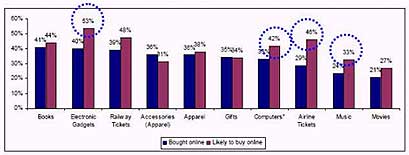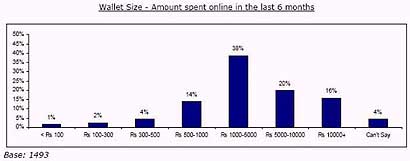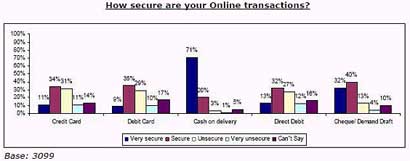The maturing of the medium
By Preeti Desai | 24 Sep 2005
One safety aspect of using credit cards is that in case of disputed payments for online transactions, the onus is on the merchants to prove that the transaction actually took place, since online users don't physically sign a credit slip. To that extent, online users are protected from fraudulent use of credit cards.
 The number of users logging on to the internet is growing by leaps and bounds. The online population is expected to touch 100 million by 2007 from the 25 million now. Accompanying this growth is an increasing maturity in the way people use the internet. It's a classical curve. Online users typically start by using e-mail, gradually move on to browsing for news, information and entertainment, and finally graduate to shopping and conducting business online.
The number of users logging on to the internet is growing by leaps and bounds. The online population is expected to touch 100 million by 2007 from the 25 million now. Accompanying this growth is an increasing maturity in the way people use the internet. It's a classical curve. Online users typically start by using e-mail, gradually move on to browsing for news, information and entertainment, and finally graduate to shopping and conducting business online.
The numbers indicate a growing sense of comfort with using the internet for shopping. In 2004-2005, Rs570 crore worth of transactions were carried out online in India, and this figure is expected to grow by an amazing 300 per cent to reach Rs2,300 crore by 2006-07.
This maturity of online users comes across clearly in a survey, Power Shopper, conducted by the Internet and Mobile Association of India (earlier known as Internet & Online Association of India).
Fifty-five per cent of users surveyed had shopped online. Of these, 34 per cent had shopped 2-4 times, 26 per cent 5-10 times and 27 per cent more than ten times. The first-time purchase patterns too show a growing affinity for online shopping. Nearly 37 per cent of respondents started shopping in the last 12 months, while a whopping 67 per cent had first shopped in the last three months.
And it's not just books and music — products long considered most suitable for online purchase — that users are buying; increasingly, users are no longer shying away from making big-ticket purchases, ranging from jewelry to electronic gadgets to railway and airline tickets (Table 1).
| Products and services bought online | % |
| Books | 41% |
| Electronic Gadgets | 40% |
| Railway Tickets | 39% |
| Apparel Accessories | 36% |
| Apparel | 36% |
| Gifts | 35% |
| Computers & Peripherals | 33% |
| Airline Tickets | 29% |
| Music | 24% |
| Movies | 21% |
| Hotel Booking | 20% |
| Magazines | 19% |
| Home Tools & Products | 16% |
| Home Appliances | 16% |
| Toys | 16% |
| Jewelry | 15% |
| Movie Tickets | 15% |
| Beauty Products | 12% |
| Health & Fitness Products | 12% |
| Apparel Gift Certificates | 10% |
| Sporting Goods | 7% |
| Base | 1,493 |
While books continue to be a leading product category, many high-value items are likely to overthrow books at the top (Table 2).
Another indication that users are becoming more comfortable with shopping online is the amount (wallet-size) they have been spending. A large number of users have spent between Rs1,000 and Rs10,000+ in the last six months (Table 3).
The conclusions are that online users are willing to splurge more, on a wider range of products and more frequently.
The factors fuelling the growth of online shopping are easy to see. The top five reasons why Indians like to shop online are:
- Home delivery (70 per cent of respondents in the IOA survey);
- Time saving (60 per cent),
- 24x7 availability (60 per cent),
- Ease of use (45 per cent) and
- Product comparisons (39 per cent).
For retailers, these numbers make a compelling case for an e-commerce presence. Besides, as more offline brands embrace e-commerce, they will encourage the adoption of the medium by their offline users as well, creating, in the process, a kind of virtuous circle.
The good thing about the internet is that it's not just large brands which can increase their sales online. Smaller players, who have a reputation for reliability and trust, can reach more customers and spread their presence to new geographies more cost-effectively through e-commerce.
The challenge for online retailers is to attract new buyers to try out online shopping and then focus on retaining customers and encouraging them to increase their online spends. To do this, they must focus on reassuring users about the security of online transactions, besides making the online process of buying easy and convenient.
In a related survey on users' perceptions about e-commerce security, IOA found that credit card misuse (67 per cent of respondents), unauthorised access to bank accounts (57 per cent) and spam (48 per cent) ranked among the major concerns of online users.
Not surprisingly, 91 per cent of users felt cash on delivery as a mode of payment for online purchases was secure. However, nearly 45 per cent of respondents vouched for the safety of using credit cards online; 42 per cent felt it wasn't safe. Direct debit and debit cards drew similar responses.
One safety aspect of using credit cards online that banks must communicate - and online users must be aware of - is that in case of disputed credit card payments for online transactions the onus is on the merchants to prove that the transaction actually took place, since online users don't physically sign a credit slip. To that extent, online users are protected from fraudulent use of credit cards.
Publishers and retailers must offer users a wide range of payment options and strive to increase their confidence in using different modes of payment. Many are already doing it through the use of globally-accepted encryption technologies and trusted third-party certifications (like those offered by Verisign). Transparency in policies (returns, privacy, shipping, etc), insurance against fraud and good customer service will encourage more and more users to take to online shopping. Another mode of payment worth thinking about is pre-paid cards of various denominations for use in online transactions.
Today's users are logging on to the internet at an earlier age than this generation did and, consequently, maturing to online shopping a lot quicker. There is no doubt, that online shopping is a market that will grow at a scorching pace. It's clearly time to put your business online!
*The author is president of the Internet & Mobile Association of India

































